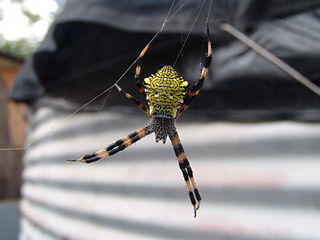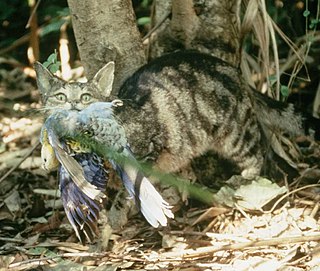
The Oceanian realm is one of the eight biogeographic realms and is unique in not including any continental land mass. It has the smallest land area of any of the WWF realms.

The Polynesian rat, Pacific rat or little rat, known to the Māori as kiore, is the third most widespread species of rat in the world behind the brown rat and black rat. Contrary to its vernacular name, the Polynesian rat originated in Southeast Asia, and like its relatives has become widespread, migrating to most of Polynesia, including New Zealand, Easter Island, and Hawaii. It shares high adaptability with other rat species extending to many environments, from grasslands to forests. It is also closely associated with humans, who provide easy access to food. It has become a major pest in most areas of its distribution.
Insular biogeography or island biogeography is a field within biogeography that examines the factors that affect the species richness and diversification of isolated natural communities. The theory was originally developed to explain the pattern of the species–area relationship occurring in oceanic islands. Under either name it is now used in reference to any ecosystem that is isolated due to being surrounded by unlike ecosystems, and has been extended to mountain peaks, seamounts, oases, fragmented forests, and even natural habitats isolated by human land development. The field was started in the 1960s by the ecologists Robert H. MacArthur and E. O. Wilson, who coined the term island biogeography in their inaugural contribution to Princeton's Monograph in Population Biology series, which attempted to predict the number of species that would exist on a newly created island.

The Guam rail is a species of flightless bird in the Rallidae family, endemic to the United States territory of Guam. It is known locally as the ko'ko' bird. It was extirpated from the entire island by the late 1980s owing to the predation of the brown tree snake, an invasive species not native to the island.

The brown tree snake, also known as the brown catsnake, is an arboreal rear-fanged colubrid snake native to eastern and northern coastal Australia, eastern Indonesia, Papua New Guinea, and many islands in northwestern Melanesia. The snake is slender, in order to facilitate climbing, and can reach up to 2 meters in length. Its coloration may also vary, some being brown, green, or even red. Brown tree snakes prey on many things, ranging from invertebrates to birds, and even some smaller mammals. It is one of the very few colubrids found in Australia, where elapids are more common. Due to an accidental introduction after the events of World War II, this snake is now infamous for being an invasive species responsible for extirpating the majority of the native bird population in Guam. Currently, efforts are being made to reduce and control the population on Guam and prevent the snake from spreading to other locations.

The flight zone of an animal is the area surrounding an animal that if encroached upon by a potential predator or threat, including humans, will cause alarm and escape behavior. The flight zone is determined by the animal's flight distance, sometimes called flight initiation distance (FID) which extends horizontally from the animal and sometimes vertically. It may also be termed escape distance, alert distance, flush distance, and escape flight distance.

The ecological restoration of islands, or island restoration, is the application of the principles of ecological restoration to islands and island groups. Islands, due to their isolation, are home to many of the world's endemic species, as well as important breeding grounds for seabirds and some marine mammals. Their ecosystems are also very vulnerable to human disturbance and particularly to introduced species, due to their small size. Island groups, such as New Zealand and Hawaii, have undergone substantial extinctions and losses of habitat. Since the 1950s several organisations and government agencies around the world have worked to restore islands to their original states; New Zealand has used them to hold natural populations of species that would otherwise be unable to survive in the wild. The principal components of island restoration are the removal of introduced species and the reintroduction of native species.

Island gigantism, or insular gigantism, is a biological phenomenon in which the size of an animal species isolated on an island increases dramatically in comparison to its mainland relatives. Island gigantism is one aspect of the more general "island effect" or "Foster's rule", which posits that when mainland animals colonize islands, small species tend to evolve larger bodies, and large species tend to evolve smaller bodies. This is itself one aspect of the more general phenomenon of island syndrome which describes the differences in morphology, ecology, physiology and behaviour of insular species compared to their continental counterparts. Following the arrival of humans and associated introduced predators, many giant as well as other island endemics have become extinct. A similar size increase, as well as increased woodiness, has been observed in some insular plants such as the Mapou tree in Mauritius which is also known as the "Mauritian baobab" although it is member of the grape family (Vitaceae).

Argiope appensa, also referred to as the Hawaiian garden spider or banana spider, is an orb-weaving spider belonging to the family Araneidae.

The fauna of Puerto Rico is similar to other island archipelago faunas, with high endemism, and low, skewed taxonomic diversity. Bats are the only extant native terrestrial mammals in Puerto Rico. All other terrestrial mammals in the area were introduced by humans, and include species such as cats, goats, sheep, the small Indian mongoose, and escaped monkeys. Marine mammals include dolphins, manatees, and whales. Of the 349 bird species, about 120 breed in the archipelago, and 47.5% are accidental or rare.

Bird conservation is a field in the science of conservation biology related to threatened birds. Humans have had a profound effect on many bird species. Over one hundred species have gone extinct in historical times, although the most dramatic human-caused extinctions occurred in the Pacific Ocean as humans colonised the islands of Melanesia, Polynesia and Micronesia, during which an estimated 750–1,800 species of birds became extinct. According to Worldwatch Institute, many bird populations are currently declining worldwide, with 1,200 species facing extinction in the next century. The biggest cited reason surrounds habitat loss. Other threats include overhunting, accidental mortality due to structural collisions, long-line fishing bycatch, pollution, competition and predation by pet cats, oil spills and pesticide use and climate change. Governments, along with numerous conservation charities, work to protect birds in various ways, including legislation, preserving and restoring bird habitat, and establishing captive populations for reintroductions.
Ecological extinction is "the reduction of a species to such low abundance that, although it is still present in the community, it no longer interacts significantly with other species".

The Italian wall lizard or ruin lizard is a species of lizard in the family Lacertidae. P. siculus is native to south and southeastern Europe, but has also been introduced elsewhere in the continent, as well as North America, where it is a possible invasive species. P. siculus is a habitat generalist and can thrive in natural and human-modified environments. Similarly, P. siculus has a generalized diet as well, allowing it to have its large range.

Bird extinction is the complete elimination of all species members under the taxonomic class, Aves. Out of all known bird species,, 159 (1.4%) have become extinct, with 226 (2%) being critically endangered. There is a general consensus among ornithologists that if anthropogenic activities continue as current trends suggest, one-third of all bird species, and an even greater proportion of bird populations, will be rendered extinct by the end of the 21st century.

Ctenosaura hemilopha, also known as the Baja California spiny-tailed iguana, is a species of spinytail iguana endemic to Baja California. It is arboreal and primarily herbivorous, although it can be an opportunistic carnivore. Males may grow up to 100 centimeters (39 in) in length, while females are smaller, with a length of up to 70 centimeters (28 in). Five subspecies are currently recognized.
Island ecology is the study of island organisms and their interactions with each other and the environment. Islands account for nearly 1/6 of earth’s total land area, yet the ecology of island ecosystems is vastly different from that of mainland communities. Their isolation and high availability of empty niches lead to increased speciation. As a result, island ecosystems comprise 30% of the world’s biodiversity hotspots, 50% of marine tropical diversity, and some of the most unusual and rare species. Many species still remain unknown.

Seabirds include some of the most threatened taxa anywhere in the world. For example, of extant albatross species, 82% are listed as threatened, endangered, or critically endangered by the International Union for Conservation of Nature. The two leading threats to seabirds are accidental bycatch by commercial fishing operations and introduced mammals on their breeding islands. Mammals are typically brought to remote islands by humans either accidentally as stowaways on ships, or deliberately for hunting, ranching, or biological control of previously introduced species. Introduced mammals have a multitude of negative effects on seabirds including direct and indirect effects. Direct effects include predation and disruption of breeding activities, and indirect effects include habitat transformation due to overgrazing and major shifts in nutrient cycling due to a halting of nutrient subsidies from seabird excrement. There are other invasive species on islands that wreak havoc on native bird populations, but mammals are by far the most commonly introduced species to islands and the most detrimental to breeding seabirds. Despite efforts to remove introduced mammals from these remote islands, invasive mammals are still present on roughly 80% of islands worldwide.

Gonatodes albogularis, which has been called a number of vernacular names in English, is a smallish species of gecko found in warm parts of Central and South America, Cuba, Hispaniola and Jamaica. They prefer to live in tropical dry forest habitats. It is sexually dimorphic: the male is colourful, while the female is a more drab grey. The fingers do not have lamellar pads for climbing smooth surfaces like many other geckos but instead have normal claws like most lizards. At one time the species had a breeding population in southern Florida, especially Key West, but this population appears to have died out by the early 1990s. They are believed to be able to tell the difference between brightness and hues of conspecifics. Males are incredibly aggressive with territory defense against both other males and potential predators.

Cat predation on wildlife is the result of the natural instincts and behavior of both feral and owned house cats to hunt small prey, including wildlife. Some people view this as a desirable phenomenon, such as in the case of barn cats and other cats kept for the intended purpose of pest control; but scientific evidence does not support the popular use of cats to control urban rat populations, and ecologists oppose their use for this purpose because of the disproportionate harm they do to native wildlife. As an invasive species and predator, they do considerable ecological damage.

Island syndrome describes the differences in morphology, ecology, physiology and behaviour of insular species compared to their continental counterparts. These differences evolve due to the different ecological pressures affecting insular species, including a paucity of large predators and herbivores as well as a consistently mild climate.

















